A few months ago archaeologists found a mass grave in a Kenyan lagoon. After the excavating process began, they noticed that a lot of the people in the grave had their hands tightly bound and were either battered or stabbed. After they were ruthlessly murdered, their killers left them to rot in the hot sun, not even burying them.
After the excavation was done, archaeologists dated the grave back to the prehistoric era. In total, there were 27 men, children, and pregnant women from 10,000 years ago who were massacred. Experts believe that the group of people had been killed off by rival hunter-gatherers. Those rivals stabbed and smashed their heads, knees, and limbs with clubs. Other findings suggest that there was a bloody war between the groups of early humans competing for territory and food.
The remains were found along a shoreline of a lagoon in Nataruk, Kenya. At that time Homo sapiens were thought to be the only species of humans left alive on the planet, as their last rivals since the Neanderthals had died.

The pottery in the same area the bodies were found suggested that it was a popular place for foraging for the hunter-gatherers in the area. It is no surprise, since West Turkana was a fertile landscape at the time. Pottery suggests that humans were also semi-settled in that particular area.
Among the women’s bodies were fish bones, which means the group of people who were massacred were fishermen. Perhaps the women were on their way back to their settlement with the fish they caught when they were murdered.
There were eight men and eight women total. One of the women was heavily pregnant. Among the adults were six children and five unidentified adults. At least twelve of the skeletons were nearly complete and ten of them showed significant signs of deadly wounds. Many were found face down and had severe fractures to their faces and heads. Five of them had wounds on their bones, which suggest they were viciously stabbed.
Two of the men had blades lodged into their skulls and thorax even after death. Others had been so beaten that their hands, knees, and ribs were smashed. The odd thing about the grave is that four people in the group were found in weird seated positions. This suggested that their hands had been tied. The heavily pregnant woman was one of those in the seated position.

After looking closer, archaeologists believe the woman was carrying a six-to nine-month fetus. The fetus was found among the bones of its mother. Looking closer, it seemed as though her hands and feet were bound and her knees were broken before she was killed.
As for the children’s bodies, they were all found next to the women’s. The cause of death of the children appeared to be from being beaten, like the women.
The most significant thing that comes out of this find is that many historians and experts believed that warfare developed 6,000 years ago. Finding this scene suggests otherwise.
One of the archaeologists on the site, Dr. Marta Mirazon Lahr from the University of Cambridge, said that the massacre actually helped her understand the origins of warfare.
Although there are many indications to prove these people had been murdered, their attackers left few clues to identify themselves. If any of the attackers were killed during the raid, they would have been carried away or buried.
The only hint the archaeologists have for identifying these people are the razor-sharp obsidian blades that were found embedded in the two victims. The rock used for the blades was not found locally, which suggest that the outsiders were possibly in the area looking for resources.
Mirazhon Lahr said that finding this group of people suggests that war was part of the inter-group relations for some of the prehistoric hunter-gatherers. Anthropologists also believe that organized violence is something that we inherited from our evolutionary past. For example, chimpanzees will group together and attack rivals, behavior which sometimes ends in deaths.
Archaeologists now believe that this may be the earliest evidence of intentional killing yet. Even though there has been evidence of violence between other hunter-gatherer groups, they have been either individuals or involved smaller groups than this one.

However, there have been 23 bodies found in a graveyard in Jebel Sahaba, Sudan which suggest that those intentional killings happened 12,000 to 14,000 years ago. What remains questionable in this case is that those bodies were buried, which could mean those individuals died separately or in smaller groups during raids or feuds. What also makes warfare unlikely is that it predates the theory by 4,000 years.
This site was discovered in 2012 in an area that had actually been a lake during the Pleistocene and early Holocene periods. During that time, it is thought that fishermen and hunters lived along the shore. Some experts think that perhaps some of the men were killed first and then the rival group decided to catch the rest and massacre them. Those bodies then fell into the water of the lagoon and were well-preserved by the sediment, eventually becoming fossilized.
After the full excavation, radiocarbon dating helped age them to be around 9,500 to 10,500 years old, which would have been right after the last ice age.
Mirazon Lahr also added that this massacre could have resulted from an attempt to seize the resources the group had already caught or gathered. They also could have been stealing all of the valuables from the group, such as their pottery. She also added that these actions are characteristic of other instances of early warfare – attacking the richer and more settled areas out of jealousy.
A professor from Cambridge University’s Leverhulme Centre for Human Evolutionary Studies, Professor Robert Foley, said that this new findings give new ideas about human evolution. He also added that he has no doubt, that it is in everyone’s biology to be aggressive and lethal, just as much as to be caring and loving.